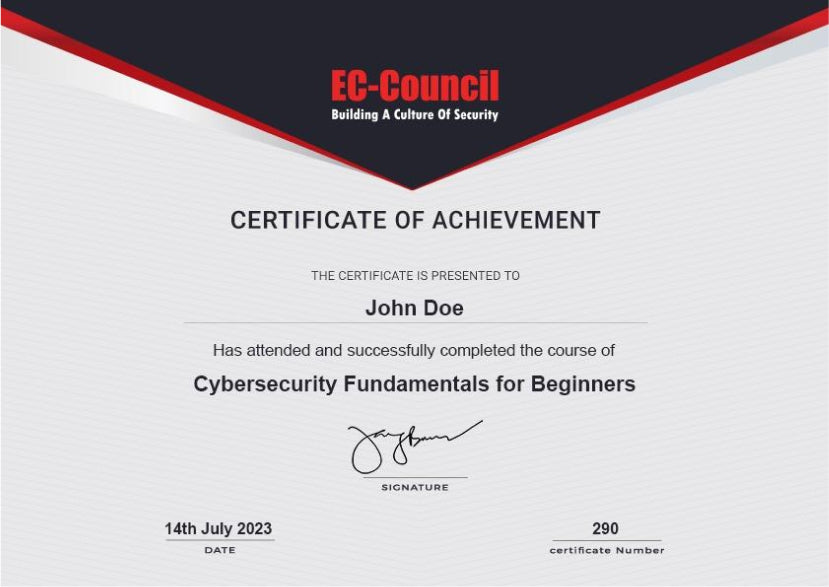
Cybersecurity Unleashed for Banks
Secure Banking Infrastructure with AI-Driven Cyber Defense, Zero Trust Security, and Advanced Threat Mitigation Strategies.
269445 Hours of video content
Beginner
Certificate of Completion Included
30 Labs
Buy this course now
$199.00Course Overview
What You Will Learn
- Implement micro-segmentation, identity verification and access control.
- Use AI-powered tools to identify and mitigate security vulnerabilities.
- Learn how to detect and defend against network-based threats.
- Secure cloud environments and enforce compliance frameworks.
- Apply AI and machine learning techniques to detect fraudulent activities.
- Understand and mitigate the most critical web application vulnerabilities.
- Recognize , prevent and mitigate social engineering and phishing attacks.
- Secure AI-driven systems and identify emerging risks.
- Implement risk assessment strategies to mitigate security threats.
- Secure authentication and user access using modern IAM frameworks.
Program Curriculum
- Chapter 1: Introduction
- Chapter 2: Fundamentals of AI in Cybersecurity
- Chapter 3: AI-powered Threat Detection
- Chapter 4: Practical Implementation Strategies
- Chapter 5: Emerging Trends in AI-driven Network Security
- Chapter 6: Best Practices and Ethical Considerations
- Chapter 7: Real-world Applications and Case Studies
- Chapter 8: Conclusion and Q&A
- Chapter 9: Capstone Exercise
- Chapter 1: Introduction
- Chapter 2: Understanding Computational Intelligence (CI)
- Chapter 3: Leveraging CI-based Security Solutions
- Chapter 4: Challenges & Future Directions
- Chapter 5: Practical Implementation and Guidelines
- Chapter 6: Summary & Conclusion
- Chapter 1: Getting Started with Information Security Compliance
- Chapter 2: Network Security
- Chapter 3: Endpoint Security
- Chapter 4: Patch Management
- Chapter 5: Encryption
- Chapter 6: Identity Governance and Administration
- Chapter 7: Getting the Audit Right
- Chapter 8: Course Summary
- Chapter 1: Introduction to GraphQL
- Chapter 2: Security Vulnerabilities in GraphQL APIs
- Chapter 3: GraphQL Pentesting Tools Setup
- Chapter 4: Reconnaissance
- Chapter 5: Exploitation: Brute Force, Batching, and Denial of Service Attacks
- Chapter 6: Exploitation: Injection Attacks
- Chapter 7: Exploitation: Forgery and Hijack Attacks
- Chapter 8: Reporting and Reported Attacks (Bonus)
- Chapter 1: World Wide Web Fundamentals
- Chapter 2: Injection Flaws
- Chapter 3: Broken Authentication
- Chapter 4: Sensitive Data Exposure
- Chapter 5: XML External Entities
- Chapter 6: Broken Access Control
- Chapter 7: Security Misconfiguration
- Chapter 8: Cross-Site Scripting (XSS)
- Chapter 9: Insecure Deserialization
- Chapter 10: Using Components with Known Vulnerabilities
- Chapter 11: Insufficient Logging & Monitoring
- Chapter 12: What Has Changed in OWASP 2021?
- Chapter 13: Server-side Request Forgery (SSRF)
- Chapter 1: An Introduction to GraphQL
- Chapter 2: GraphQL Vulnerabilities
- Chapter 3: Hands-on Lab
- Chapter 4: Prevention and Best Practices
- Chapter 5: Wrapping Up
- Chapter 1: Fundamentals of Cloud Security
- Chapter 2: Cloud Computing Models
- Chapter 3: Cloud Service Providers
- Chapter 4: Risks in Cloud Security
- Chapter 5: Cloud Security Principles
- Chapter 6: Cloud Security Governance
- Chapter 7: Cloud Security Tooling
- Chapter 8: Cloud Security Certifications
- Chapter 9: Landing the Job
- Chapter 10: Infrastructure as Code: Introduction
- Chapter 11: Infrastructure as Code: Installing Terraform
- Chapter 12: Infrastructure as Code: Hands-on with Terraform
- Chapter 13: Serverless Computing: Introduction
- Chapter 14: Serverless Functions: AWS Lambda
- Chapter 1: Global View
- Chapter 2: Hash Functions
- Chapter 3: Random Number Generator and Key Generation
- Chapter 4: Symmetric Encryption
- Chapter 5: Message Authentication Code (MAC)
- Chapter 6: Asymmetric Encryption
- Chapter 7: Digital Signature
- Chapter 8: Key Exchange
- Chapter 9 : PKI
- Chapter 10: More Cryptography Tools
- Chapter 11: Post-Quantum Cryptography Primitives
- Chapter 1: Introduction
- Chapter 2: Types and Phases of the Information Security Risk Management Process
- Chapter 3: Phases of the Information Security Risk Management Process
- Chapter 4: Information Security Controls
- Chapter 5: Third-party Information Security Risk Management
- Chapter 6: Vulnerability Management, Penetration Testing, and Red Teams
- Chapter 7: Conclusion
- Chapter 1: Introduction to Identity and Access Management (IAM)
- Chapter 2: Introduction to Keycloak and Basic Configuration
- Chapter 3: Advanced Keycloak Features and Integration
- Chapter 4: Introduction to FreeIPA and Basic Configuration
- Chapter 5: Advanced FreeIPA Features and Integration
- Chapter 6: Introduction to OpenIAM and Basic Configuration
- Chapter 7: Advanced OpenIAM Features and Integration
- Chapter 8: Empowering Security: Final Insights on Open-source IAM Solutions
- Chapter 1: How Hard is it To Get Hacked?
- Chapter 2: Targeted Email Phishing and Social Engineering
- Chapter 3: Macro Malware
- Chapter 4: Business Email Compromise
- Chapter 5: Instant Messaging
- Chapter 6: Smishing
- Chapter 7: Vishing
- Chapter 8: Ransomware
- Chapter 9: Cryptomining
- Chapter 10: Red Flags
- Chapter 11: Search Engine Optimization
- Chapter 12: Banking Trojan
- Chapter 13: Fake Antivirus
- Chapter 14: Apple
- Chapter 15: Smartphones and Mobile Apps
- Chapter 16: Password Management
- Chapter 17: 2-Factor Authentication
- Chapter 18: Browser Security
- Chapter 19: Internet Data Privacy
- Chapter 20: Social Media
- Chapter 21: Disinformation
- Chapter 22: Identity Theft
- Chapter 23: GDPR
- Chapter 24: Encryption
- Chapter 25: IoT/Internet of Things
- Chapter 26: What Else Can You Do to Protect Yourself?
- Chapter 1: Introduction to Generative AI and LLMs
- Chapter 2: Choice of LLMs and Other Multi-modal Models
- Chapter 3: LLM-RAG Applications and Vector Databases
- Chapter 4: Crafting Effective Prompts
- Chapter 5: System and Data Preparedness
- Chapter 6: Code Generation with LLMs
- Chapter 7: Windows Troubleshooting with LLMs
- Chapter 8: Linux Troubleshooting with LLMs
- Chapter 1: Introduction to Threat Hunting
- Chapter 2: Hunting TTPs
- Chapter 3: Hunting Logs and Events
- Chapter 4: Hunting Network Traffic
- Chapter 5: Hunting with a SIEM
- Chapter 6: Hunting with Other Tools
- Chapter 7: Hunting Use Cases
- Chapter 8: Course Conclusion
- Chapter 1: Introduction to Generative Artificial Intelligence
- Chapter 2: Exploring OpenAI and the Evolution of GPT Models
- Chapter 3: Overview of Vulnerability Detection
- Chapter 4: Web Application Security Essentials
- Chapter 5: AI-Powered Vulnerability Detection and Analysis
- Chapter 6: Practical Applications and Prompts
- Chapter 7: AI in Cybersecurity: Risks, Ethics, and Defense Strategies
- Chapter 1: Enterprise Incident Response
- Chapter 2: Cybersecurity Frameworks
- Chapter 3: How to Define Assets?
- Chapter 4: Security Operations and Other Security Teams
- Chapter 5: Preparations
- Chapter 6: Disaster Recovery
- Chapter 7: Insider Threats
- Chapter 8: Indicator of Compromise (IOC)
- Chapter 1: Introduction to Physical Security
- Chapter 2: Securing Operating Systems
- Chapter 3: Clear Desk and Removable Media Policy
- Chapter 4: Internet Security
- Chapter 5: Diving into Malware and Viruses
- Chapter 6: Security on Social Networking Sites
- Chapter 7: Securing E-mail Communication
- Chapter 8: Securing Mobile Devices
- Chapter 9: Securing the Cloud
- Chapter 10: Network Connections
- Chapter 11: Data Backup and Disaster Recovery
- Chapter 1: Understanding Fraudulent Transactions
- Chapter 2: Data Preprocessing Techniques for Fraud Detection
- Chapter 3: Supervised Learning for Fraud Detection
- Chapter 4: Unsupervised Learning for Fraud Detection
- Chapter 5: Ensemble Learning for Fraud Detection
- Chapter 6: Feature Selection Techniques for Fraud Detection
- Chapter 7: Applications of Data Mining for Fraud Detection
- Chapter 8: Latest Trends and Future Directions in Data Mining for Fraud Detection
- Chapter 1: Foundational Security Concepts
- Chapter 2: The Threat Landscape
- Chapter 3: Application Security
- Chapter 4: Identity Management
- Chapter 5: Micro-segmentation
- Chapter 6: Application Access
- Chapter 7: Threat Protection
- Chapter 8: Incident Management
- Chapter 9: Conclusion
- Chapter 1: Introduction to Dark Web
- Chapter 2: Importance of the Dark Web and How Dangerous It Is
- Chapter 3: Staying Safe on the Dark Web
- Chapter 4: Cyber Threat Intelligence and Dark Web
- Chapter 5: Dark Web Automation
- Chapter 6: Conclusion
Instructor
Karen Walsh
Karen Walsh is a lawyer and former internal auditor turned cybersecurity and privacy regulatory compliance subject matter expert. She worked in financial services for 12 years and spent 11 years teaching at the college level. She’s worked with leadership teams as a contract compliance manager, developing programs and guiding staff to establish best practices. During her time teaching at the University of Hartford, she received the “Sustained Excellence in Teaching Award for Part-Time Faculty.” She’s been published by the ISACA Journal, Dark Reading, HelpNet Security, Nextgov, Security Boulevard, Security Magazine, TechAeris, and Techspective. She also writes for GeekMom where she discusses her passion for Star Wars, Marvel, and LEGO.
Jeff Minakata
Jeff Minakata has worked in the IT industry for over 22 years. He holds various cybersecurity certifications, networking certifications, and engineering certifications such as C|OSINT Certified, trained in CEH v8, CEH v9, CEH v11, CISP, Metasploit certified, Accredited Configuration Engineer (ACE), MCSI OSINT Practitioner, and CWA certified. He is an Online Instructor for OSINT, ethical hacking, and network security. He has contracted courses for EC-Council, Udemy, and has written articles for Hackin9 and eForensics magazine. Jeff currently works on the computer networking side and teaches ethical hacking, OSINT, and cybersecurity online. He is passionate about helping people understand OSINT, ethical hacking, and cybersecurity.
Teni Omole
Teni Omole is a seasoned security professional with over a decade of experience in designing, securing, and testing computer systems for diverse industries including banking, fintech, healthcare, and media. Currently serving as the CISO at Cognideck UK, a London-based consulting firm, Teni leads in safeguarding digital infrastructure. His role as a Software Engineer at Cognideck showcases proficiency in ISO standards, Azure DevOps, Python, Kubernetes, and more. Previously, at Linkedlist Technologies, Teni managed end-to-end projects, from WordPress websites to custom e-commerce solutions using Python Django. This period honed skills in Bootstrap, Django, and PHP. Earlier, as the founder of Semtec Technologies, he conceptualized, developed, and marketed School Management Software, highlighting strengths in HTML, CSS, JavaScript, PHP, and MySQL. Teni's journey underscores a trajectory of expertise, spanning entrepreneurship, project management, and cybersecurity. His rich skill set and adaptability across languages and frameworks define him as a dynamic professional in the realm of technology and security.
Angelos Markou
Angelos Markos is an experienced Data Scientist with over 11 years of experience in the field of fraud detection and prevention. With a background in e-commerce and banking, Angelos has worked for several companies and is widely regarded as an expert in data mining for fraud detection and has a proven track record of successfully detecting fraudulent activity and preventing potential losses for businesses and individuals alike. Through Angelo's e-course on Data Mining for Fraud Detection, you can be sure that you'll receive the best possible training from a highly qualified and experienced professional.
Marcos Vinicios Penha
Marcos Vinicios Penha has worked in companies in south and north America over the last 20 years. His experience ranges from defensive, offensive, incident response and infrastructure security. He has a variety of certifications in different fields of cyber-security, including CEH, CISSP, CRTE, CRTP, OSCP, F5-CA, Pentest+, CySA+, CASP+, Linux+, and others. Marcos has supported many companies worldwide to fight vulnerabilities, cyber-crime and advanced persistent threats while helping them to improve their maturity, visibility and protection controls. He has solid knowledge about the following subjects: Vulnerability Management, Red teaming, Ethical Hacking and Adversary Simulation, System Hardening, Defense Evasion, Threat Hunting, Incident Response, Blue teaming, Intrusion Detection and Prevention, Endpoint Detection and Response, Next-Gen Firewalls and Web Application Firewalls, and others. Marcos has been supporting the cyber-security community participating as a speaker in a variety of events worldwide.
Tyler Wall
With over a decade of experience specializing in Security Operations Centers (SOC), Tyler Wall enjoys teaching and mentoring new cybersecurity talent. He has obtained a Master of Science in Cybersecurity from Purdue University and certifications including the Certified Information Systems Security Professional (CISSP), Certified Ethical Hacker (CEH), Cloud Certificate of Security Knowledge (CCSK), Certified Forensic Security Responder (CSFR), Security+, Network+, and many others. He is the author of the popular book Jump-start Your SOC Analyst Career and Udemy course Cybersecurity: Security Operations Center (SOC) Analyst NOW! Tyler lives in Cumming, Georgia and enjoys spending time with his wife and son (5) above all other things. Other than family and technology, he also enjoys history, science, and the arts. He treasures his lifetime subscription to National Geographic given to him in a beautifully framed certificate by his grandfather when he was born 36 some odd years ago. His grandfather was a West Point graduate and retired from the Army as a Colonel to become a history teacher. His grandmother was a University of Georgia graduate in a time it was rare for women to be educated or have careers, who spent her career teaching. His mom was also a University of Georgia graduate and teacher, Kindergarten teacher. Retired now but enjoys visiting her Grandson's school and volunteering to be a guest reader to his and other Kindergarten classes at the school. Some of Tyler's other leisure magazine readings include subscriptions to Astronomy, QST, Knights Templar, and Masonic Messenger. He is a Master Mason in good standing and has continued his masonic education all the way through the York Rite: Royal Arch, Cryptic Masons, and up to the terminal Knights Templar degree. He has a long-time fascination with Kryptos, the sculpture at the CIA HQ, and is part of a community that is working on deciphering the unsolvable puzzle. He works on the riddles that the ciphertext decodes to. In other words, he tries to figure out what the English means when gibberish is translated and he's made significant progress. It has spawned hobbies with ham radio and egyptology that continue to today. My QRZed is good: KO4UUT. Speaking of hobbies, art and design is something he finds himself doing from time to time. He owns a Bambu 3D printer and often designs functional models in Fusion360 and prints them out. He also, when he is moody, likes to create art therapeutically. He is much better at art appreciation than creation, but that doesn't stop him from trying to create something rudimentary to pass off to a professional to design. All of the images found in his course were created by him and refined by a graphic designer. He owns his own library and collects rare books. Most collectables are autographed biographies of people he identifies with that have had similar struggles in life. He also has a couple of very old first editions and autographed books from his friends who are also authors. He takes good care of plants on his bookshelf that are working hard to collect the dust. Snake plant, peace lilly, and pothos to be exact. There are also some books on his bookshelf that get used frequently, often having two copies, one to collect and one to read. His favorite book of all time, is Treasures of World History: The Story of Civilization Told Through Its 50 Most Important Documents. Its not a popular book, and it seems to be a mystery how he even ended up with it. His wife bought it for his birthday, and doesn't remember where or how she got it. It was an insignificant last minute present she picked up to add to the rest of his gifts. Tyler is most interested in what store liked this book so much that they kept it in stock, because he likes them. He's had it for a couple of years and still learning interesting things that makes him question the integrity of history, science, technology, religion and many other subjects. Written by a famous journalist couple who are familiar with tall tales. He could write for a long time about this book. In fact, Tyler could write a long time on just about anything. What he enjoys most about his career is being able to relate and talk to people about things he knows stuff about. Being not a fan of discussing religion and politics, in fact very much opposed to the subjects, he sometimes has trouble having normal everyday conversations. He doesn't talk much usually, and prefers to read and write, but there's something about the collaboration of working together in cybersecurity that makes him pipe up. He has an interest in creating a course on cracking history's mysteries as a common Facebook post of his would regard disappointing realities of stories we thought we're so familiar with. He is tons of fun on Facebook. He also has an interest in creating a more practical course on Cloud Security, called Cloud Security NOW! complete with its own brand unique to SOC Analyst NOW. He is the founder of Cyber NOW Education, a hobby business and creative outlet, started because he was so sick of for-profit degree mills taking advantage of students and leaving them with skills that aren't applicable to finding entry level work. He spent a lot time interviewing these poor people who are $50,000 in debt and a fresh piece of paper and he had to tell them they weren't qualified for basic cybersecurity work.
Reza Zaheri
Reza Zaheri is a cyber security professional with over 15 years of leadership and hands-on experience working Cyber Security with Fortune 100 companies. He has lived and breathed cyber security for a very long time: having spent the first few years of my career conducting numerous security assessments and managing a Security Engineering team. He has then moved on fight the bad guys on the cyber front lines for the past 10 years, by directing Digital Forensics and Incident Response teams for Fortune 100 companies. He was responsible for incident detection, investigation and digital forensics of all cyber security incidents across the United States, as well as providing digital forensics assistance to Latin American regional offices. He managed and participated in hundreds of investigations, working with the FBI and DHS at times, and saw first hand how the bad guys were trying to break into our computers, emails, mobile phones and networks. And it was also during this time, using all the first-hand knowledge he had gained over the years, that he decided to create my very own Enterprise Security Awareness program, whereby he presented the engaging cyber security training either in-person, or via online videos, to 30,000 of his fellow employees across the United States and Latin America.
Paulo Silva Silva
Paulo Silva holds a bachelor’s degree in computer science and a master in Innovation and Technological Entrepreneurship. With more than 15 years professional experience as software developer, in the last 6 years he has been completely focused on security. Nowadays he is an independent senior security researcher, collaborating with several organizations to find and fix security weaknesses in their systems.
Since 2010 Paulo is OWASP’s volunteer contributing to several projects such as the OWASP Top 10 and OWASP API Security Top 10 in which he is the main contributor. He’s also the OWASP Go Secure Coding Practices project leader.
Used to attend security conferences all over the world, Paulo is frequently invited to deliver awareness and security training in the academia. He has also authored several security articles and secure programming guides.
Feriel Mufti
Feriel Mufti is a dynamic cybersecurity professional based in Luxembourg. Holding both a Bachelor's and Master's degree in Computer Science and Cybersecurity Engineering, Feriel is well-versed in the intricacies of IT landscapes. Currently serving as part of the service delivery management team at PwC Luxembourg, Feriel specializes in Identity and Access Management (IAM) activities and Change Management. Her proactive approach and ITIL certification highlight her dedication to excellence in IT service management. With a keen focus on enhancing and securing organizational IT infrastructures, Feriel has garnered invaluable experience working with prestigious clients such as CACEIS, Kyndryl, and Croix Rouge. Her expertise in IT auditing and risk assurance further solidifies her standing as a trusted professional in the field.
Hazly Amir
With over two decades of dedicated experience in information technology, Hazly Amir boasts a diverse foundation. As a Security professional, he actively contributes to cybersecurity, excelling in vendor management, onboarding, analytics, and a steadfast commitment to security compliance. Proficient in Kali Linux, Agile Methodologies, and cybersecurity, Hazly's roles include Data Communication & Networking Lab Researcher, Data Science Lab Researcher, Advanced Communication Network Researcher, IP-Core Network Technologies Researcher, and Network Protocol Researcher, reflecting his ongoing dedication to innovation.
Beyond technical expertise, Hazly demonstrates effective communication through presentations, strategic thinking in mitigation, and excels in team management and strategic planning. His commitment to continuous learning positions him as an asset in the ever-evolving information technology landscape.
Omar Rajab
Omar is a Cybersecurity analyst and penetration tester at Black Hatch, with up to 4 years of experience in ethical hacking. He writes his own Security tools, and vulnerability studies and mitigates them including planning and implementing security measures to protect computer systems, networks, and data. In addition, he teaches several cybersecurity subjects and delivers many training programs covering mobile hacking, network hacking, offensive, and defensive, and most importantly delivering security awareness for all ages.
Lei Xu
Dr. Lei Xu is an assistant professor at the University of Texas Rio Grande Valley. He has more than 10 years experience in cybersecurity research and development. He worked for both industry and academia and has a deep understanding on the challenges an engineer may face when dealing with cryptography tools.
Mark Murphy
Mark Murphy works as a Security Engineer at Cyderes. Before that, he spent years in various analyst and consultant roles. He has experience developing enterprise incident response plans for Fortune 500 companies, investigating global incidents, and leading global incident response efforts. He has a bachelor’s degree in IT Network Management and two master's Degrees: one in Information Security management and the other in Digital Forensics. He also holds a number of professional certifications and has experience teaching at different colleges and universities.
Mark Schimmelbusch
Mark Schimmelbusch has been a security consultant for large Enterprise customers for the past 8 years and has been working in various security roles for the past 18 years. His experience has been in working with large Financial Services and Public Sector clients, such as the Department of Defense. He has certifications from the Project Management Institute and the International Information System Security Certification Consortium.
Manas Dasgupta
Manas holds an MSc in AI-ML from Liverpool John Moores University (LJMU), UK. His expertise includes Generative AI (RAG application development using frameworks like LangChain and LlamaIndex), Machine Learning, Data Science, and Predictive Analytics, with a focus on techniques such as Supervised and Unsupervised Learning, Deep Neural Networks, and Clustering.
His research focuses on Natural Language Processing (NLP) using Deep Learning methods like Siamese Networks, Encoder-Decoder techniques, and Language Embeddings (e.g., BERT).
With over 20 years of experience in IT, primarily in Financial Services, Manas has developed solutions for top banks and institutions, including Natwest, ANZ, KBC, Visa, and Experian.
Ali Dorri Dorri
Ali Dorri is a security expert specializing in application security and penetration testing. He holds a PhD in computer science from UNSW, Australia, with his research in the security and privacy of IoT gaining significant attention in academia, amassing over 8,000 citations. Ali combines deep cybersecurity expertise from both academia and industry, with hands-on experience in penetration testing and security research. He holds top industry certifications, including OSCP and CISSP, further solidifying his position as a trusted expert in the field.
Brian Newman
Brian Newman has worked for the three largest telecommunications companies in the US over the last 30 years. His experience has been in both wireless and wireline networks, focusing on deploying systems, improving operations, and transforming business processes. He has certifications from the Project Management Institute, Scaled Agile, and Verizon in Lean Six Sigma. In 1998, he received a US Patent [#5,835,907], which supported the initial integration of GPS data and cellular networks, leading to the use of smartphone geolocation and mapping that is common around the world today. Newman sees 5G as genuinely transformational and, as such, it has to have security that will enable it to provide less latency, higher bandwidth, and support for millions of concurrent attached devices. He is deeply involved in building and constructing 5G networks that have the right infrastructure from Day 1.
Deyan T Tsanov
Deyan Tsanov has worked for large organizations over the last 10+ years. His experience includes technical support, cyber security operational activities, data risk analysis and evaluation, information security risk management, security controls implementation, and others. Graduated within the Information Security subject, he has additionally gained a variety of industry certifications to contribute to his subject matter expertise including Certified Ethical Hacker (CEH), Information System Security Management Professional (ISSMP), Certified Cloud Security Professional (CCSP), Certified Information System Security Professional (CISSP), Practitioner Certificate in Information Risk Management (PCiIRM), Security+ and others. Deyan sees Information Security Risk Management (ISRM) as an ever-evolving process that is key to preserving data, establishing successful information security programs, and being an inevitable pillar in each decision related to organizations’ strategy.
Tahir Balarabe
Tahir is a passionate cybersecurity professional with a First Degree and a Master's Degree in Computer Science. He has dedicated over several years to safeguarding the digital realm. His academic foundation and diverse experience have equipped him with a deep understanding of cybersecurity's complexities. He’s a seasoned expert in vulnerability management, applying risk-based strategies to prioritize and mitigate threats effectively. As an application security specialist, he has honed his skills in secure coding, threat modeling, and vulnerability assessment, ensuring robust application security. His experience as an AI Writing Evaluator at a leading AI organization and an Information Governance expert at a dynamic startup has broadened his perspective on AI-driven threats and defenses. He is proficient in both static and dynamic code analysis, identifying vulnerabilities early in the development lifecycle. Passionate about empowering others, he develops and delivers comprehensive security training programs. Currently, He is involved in three exciting projects that will further expand his knowledge and impact in the cybersecurity field.
Buy this learning path now
$199.00Couldn't load pickup availability
Get Immediate access for one year today!
Upgrade to Pro Plans and Get Full Access Today!
Get this course, along with 700+ courses and 50+ learning paths and more in one subscription. Learn more
Unlock All AccessPlans start from $33/mo. Cancel anytime.
Join over 1 Million professionals from the most renowned Companies in the world!

Empower Your Learning with Our Flexible Plans
Invest in your future with our flexible subscription plans. Whether you're just starting out or looking to enhance your expertise, there's a plan tailored to meet your needs. Gain access to in-demand skills and courses for your continuous learning needs.
Pro
Ideal for continuous learning, offering video-based learning with 840+ courses and diverse Learning Paths to enhance your skills.
What is included
- 840+ Premium Short Courses
- 70+ Structured Learning Paths
- Validation of Completion with all courses and learning paths
- New Courses added every month
Pro +
Experience immersive learning with Practice Labs and CTF Challenges for comprehensive skill-building.
Everything in Pro and
- 1400+ Practice Lab exercises with guided instructions
- 150+ CTF Challenges with detailed walkthroughs
- New Practice Labs and Challenges added every month
Pro
Ideal for continuous learning, offering extensive resources with 840+ courses and diverse Learning Paths to enhance your skills.
What is included
- 840+ Premium Short Courses
- 70+ Structured Learning Paths
- Validation of Completion with all courses and learning paths
- New Courses added every month
Pro +
Experience immersive learning with Practice Labs and CTF Challenges for comprehensive skill-building.
Everything in Pro and
- 1400+ Practice Lab exercises with guided instructions
- 150+ CTF Challenges with detailed walkthroughs
- New Practice Labs and Challenges added every month
Related Learning Paths
-
Skill Path
Learn to perform scanning and attacking effectively
2 Premium Courses
11 hr 53 m
Learn to perform scanning and attacking effectively
$99.00Hello
-
Skill Path
Become a High-level Programmer Equipped with Secure Software Development Skills in C, C++, Java, and Python
5 Premium Courses
42 hr 47 m
Become a High-level Programmer Equipped with Secure Software ...
$149.00Hello
-
Skill Path
Learn about the various cyber-threats that revolve around the IoT and smart city world, and how to defend against them.
6 Premium Courses
27 hr 52 m
Learn about the various cyber-threats that revolve around the...
$199.00Hello
-
Skill Path
Learn security coding practices and defensive measures needed to design and build a secure Java application.
6 Premium Courses
33 hr 14 m
Learn security coding practices and defensive measures needed...
$99.00Hello
-
Career Path
Begin DevOps Career as an Absolute Beginner | Linux, AWS, Scripting, Jenkins, Ansible, Azure, Docker, K8s, N-Tier Projects
5 Premium Courses
84 hr 29 m
Begin DevOps Career as an Absolute Beginner | Linux, AWS, Scr...
$199.00Hello
-
Skill Path
Gain expertise in one of the most underrated but useful skill in ethical hacking.
10 Premium Courses
49 hr 21 m
Gain expertise in one of the most underrated but useful skill...
$199.00Hello
-
Skill Path
Arm yourself with essential cybersecurity skills to protect the ever-critical healthcare infrastructure.
4 Premium Courses
13 hr 26 m
Arm yourself with essential cybersecurity skills to protect t...
$199.00Hello
-
Career Path
Become a Digital Imaging Professional Without Spending a Fortune on Your Training!
5 Premium Courses
49 hr 52 m
Become a Digital Imaging Professional Without Spending a Fort...
$199.00Hello
Quick View
Cybersecurity Unleashed for Banks
What's included
- Full Video Access
- Self-Paced Study Guide
- 6 months of access to virtual labs
- Once redeemed, this bundle will be valid for 12 months
- Self-Paced Study Guide
- Exam Voucher + Retake
Couldn't load pickup availability












